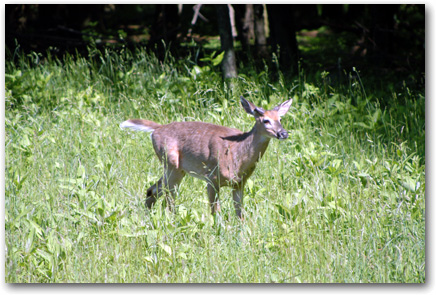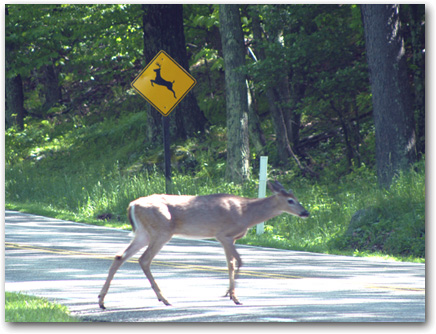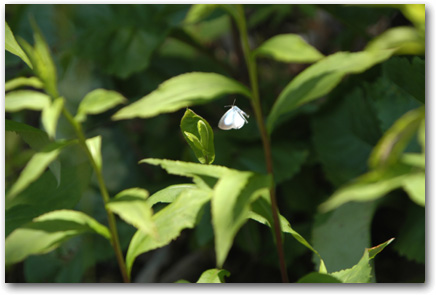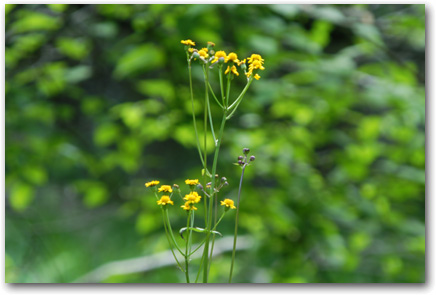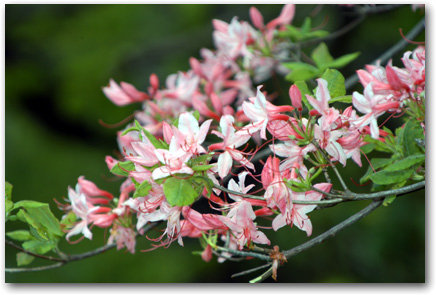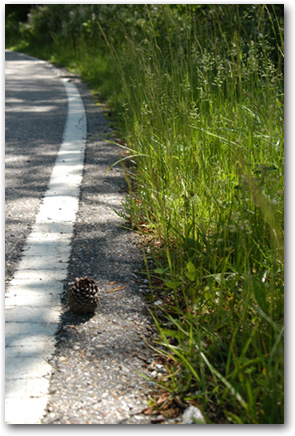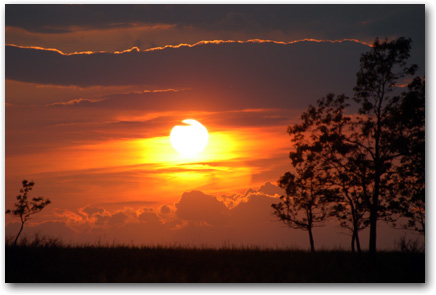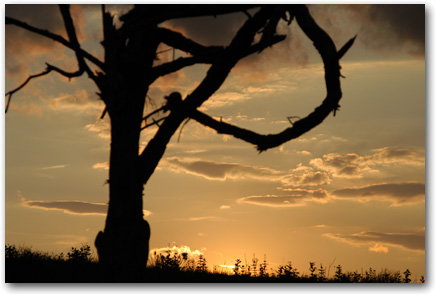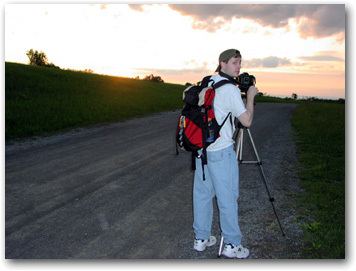Earlier this week, I had the chance to visit Virginia’s Shenandoah National Park for a quick trip. While there, I crammed in some quick hiking and photography. A selection of spring photos from Shenandoah is shown below.
During the trip, I saw a sampling of Shenandoah’s wildlife: three wild turkeys, some daring squirrels leaping onto Skyline Drive, and even a black bear scampering into the woods. Seeing a bear is a lucky break, but there’s one animal that is so populous at Shenandoah that it’s nearly impossible to go more than a few minutes without seeing one: deer.
The deer are bountiful and tame, often grazing near the side of the road (or standing in the middle of the road, waiting to shock motorists as they round a corner), and turning out in large quantities in the fields of Big Meadows during dawn and dusk.
The above photo was a snapshot I wasn’t about to miss. (Didn’t the deer know she’s going the wrong way?)
According to a ranger with the Park, deer overpopulation is quite severe this season, with lots of new fawns being born this spring. Hunting is prohibited in National Parks, and the deer face practically no natural enemies (except Fords and Toyotas).
All of the moisture this spring -; along with snowmelt from a snowy winter -; has generated healthy flora and roaring waterfalls throughout the length of the Shenandoah. Wildflowers were in bloom, and the forest ground was paved with carpets of green fern.
Clouds lingering on the horizon helped break the sun’s setting rays into shades of brilliant orange and red.
All photos (except the one above, showing the author) were taken by M. Scott Smith.
Very nice pictures. What camera do you use?
Hi Myrto! Thanks. I use a Nikon D100, Nikon's "prosumer" digital SLR. It's digital, but allows the use of normal Nikon lenses and accessories, along with giving full manual control. All of the photos were taken with a Tamron 28-300mm lens. The Tamron has a nice focal length range, but suffers a bit in sharpness and speed.
I normally perform some color correction in Photoshop. I bought the D100 when it came out last year, and have been really pleased with it. (It is much heavier and more expensive than traditional digital cameras, though.)
Hey Scott! Great photos as always! I'm working at the local paper now, and I scan my negs into the computer, without making prints. Anyhow, I've noticed that the scanned image leans towards cyan. Thus, curves and brightness/contrast/sharpness have to be adjusted. Other than that, do you adjust anything else?
Hi Jarrett! Those adjustments cover most situations. I usually start with Photoshop's Auto Levels feature (shift-command-L on a Mac, memorized 'cause I use it so much), and 7 times out of 10 that makes the photo look better, automatically adjusting color balance, contrast, and the like. Sometimes it makes the photo look worse, though, which is why I also have undo (command-Z) memorized.
Almost any camera or photographic process (scanning, etc.) will introduce some "biases" -- leaning towards cyan or cool colors, for example. Photoshop makes it so easy to compensate.
I tend to be from the "old school" of photography, where I'm hesitant to do too much digital manipulation. In college, I had a photography professor who did not allow us to do any cropping in the darkroom, as he wanted us to focus on framing in the field. So I rarely crop my photos. (None of the photos I took above were cropped, except the very bottom one, but I didn't take that so that doesn't count. :-)
I also prescribe to the "thirds" rule, trying to frame the photo so elements fall into line with imaginary "thirds" dividing the photo. In looking at the shots I took above, I follow that in most (and do so subconscioously now): the tree is a third over from the left; the pine cone is a third up from the bottom; the dark background in the top deer shot covers about a third of the frame; etc. Research has shown that most people find photos fitting the "thirds" rule to be more visually interesting. I hate (hate!) centering subjects in most cases. I also tend to hate posed photographs; I'm trying to preserve reality on film (or magnetic media, at least), and people don't normally stand and smile! So I like candid shots. (Oh, and that bottom shot of me was candid, which is why I look a little surprised/angry.)
I guess I'm getting off subject, but I didn't think you'd mind since you're a fellow photography fan!
Oh, and I should point out that the photos of the deer were completely candid. The deer had no idea I was taking photos of them. :-)
I have to agree with all you have said! I'm a student at the New York Institute of Photography, and have learned a lot! Right now I'm learning about lighting. I try to frame great in the field, and stay away from digi manipulation. However, for the newspaper, I sometimes have to crop to get the most important details even larger.
Scott:
I've read that outdoor photography (especially when snow and sun are involved) should be done late or early in the day. Given the power of Photoshop, is this "rule" outdated? Can you comment?
I notice that many of your shots (especially winter scenes) are taken late in the day. Is that because you like sleeping late :) or for effect?
JDS
Dawn and dusk are always some of the best times to take outdoor photos. (Pick whichever ones fits in best with your sleeping style. :-) At these times, the lighting is more dramatic and dynamic, and long shadows add depth. On a sunny mid-day, the sun has a lot of glare and lighting is flat. Light hitting the top of objects usually isn't very flattering.
Clouds and fog can make light do interesting things, and I love photographing in these conditions. This runs counter to most peoples' expectations -- you might be bummed that the sun isn't out when you're taking pictures. But take a look at the two Wisp photographs that were included in the mountain biking article I posted last night (these photos were provided by Wisp) -- there's a lot of fog, but I think it helps the photos a great deal. It increases contrast (making the green shrubbery jump out more, along with the color on the mountain bikers), and adds a definite "mood" to the photograph that would be missing in a sunny mid-day shot. The mood helps reinforce the feeling that this is a rugged, demanding race.
I don't believe Photoshop outdates this rule. Photoshop is great at making minor adjustments, but you're still working with the bits provided by the camera and there's only so much you can do. With Photoshop, I could take one of those foggy Wisp photos and selectively amp up the color on the mountain bikers to make them stand out even more. (Or I might apply a "fish eye" filter to the second Wisp shot, to make the edges warp out.) But I can't play too many games with lighting. I could mask out the fog and add in artificial blue sky, but then the lighting in the rest of the photo would be off, and it would look odd.
continued...
John, photo shop is a wonderful tool. However, one must be prudent not to use it to doctor up a shot. The motto for shooting in sunlight used to be "f/16 and the inverse of the film speed", or something to that extent; now I like to joke that it's "f/16 and Photoshop" for many people. In other words, why take the time to get the technically sound shot when Photoshop can be almost as good? That's something that I think both Scott and I try to stay away from. The only time I super lighten an image is when I can tell that the negative was much lighter than the original scan, or that the shot is being used in the newspaper. There I have to lighten heavily so the shot will look right once printed on newsprint.
As far as lighting goes, shooting in the early morning or late afternoon is good for several reasons. First, and this one isn't a big deal, but the weather is generally nicer. Secondly, lighting that comes at the subject from 45 degrees is much more natural looking than 90 degree light, such as the noonday sun. The light in early and late day is also much warmer, and the shadows in places such as the eyes isn't as sharp.
I hope Scott doesn't mind that I answered, and I'm sure he can add some more!
In the darkroom, we learned the limits of corrections we can make to "help" a bad photo. If a shot is overexposed, you can try to underexpose the print (or vice-versa), but this has ramifications on color range and contrast -- you can only do it so far, and only for photos that are slightly under or overexposed. Photoshop is a bit more flexible, but the same concept holds true. If a photo is very blurry, I can't sharpen it in Photoshop, because the true detail wasn't captured on film (or memory card). Photoshop can try to simulate sharpening the photo, but this process reduces resolution dramatically and can only help with very slightly blurry shots.
Snow is one of the most challenging conditions to photograph in! When cameras are trying to determine exposure, they look at the entire frame and try to "average" the exposure to a specific shade of gray referred to as 18% gray. In essence, if you took a card which had this exact shade of gray, and placed it in front of the camera, cameras are optimized to make that 18% gray expose perfectly.
Snow is a lot of white, which really throws off this averaging. Because there is so much brightness, cameras will shorten the exposure or narrow the iris to let less light in. The result is that anything that isn't white (such as the skier you're trying to photograph) will be underexposed -- overpowered by all that white.
The solution is usually to spot meter, although not all cameras support this. In spot metering, you basically focus in only on the subject (such as the skier, not the snow), and tell the camera to do its metering only from that area. Then it locks in its calculations when you take the full shot. The subject should then be exposed properly. (The snow will be overexposed, but it's already white, so no matter!) Photographing at dawn or dusk in snow is really challenging -- if you're trying to shoot subjects, you'll usually need to add artificial lighting.
Hi Jarrett, I don't mind at all! I think we photographers have overtaken this article, and I know I keep digressing into stray areas. (John's probably thinking he's sorry he asked right about now. :-)
Ethics certainly plays a role in digital photography. It's very easy to introduce or modify elements in a photograph that change its meaning. There are perfectly legitimate times to do this -- in the recent "Places you may Never Ski" article by John, I made an artificial ski area for effect that was a combination of several different photos. I was trying to make a surreal and unearthly ski scene, hoping it would be clear that the image was not meant to be Slovakia, the subject of the article. The main ski area was Vail on a very overcast day. The sky was from a sunset shot on the plains just east of Denver. The white slope in the foreground underneath the title text was artificially extended -- it wasn't nearly that big.
For purely photojournalistic shots, I believe Photoshop's use should be limited to making minor corrections to make the photo more reflective of the actual scene. It should never change the meaning.
Where's the line? I've come close to it, but try never to cross it. In the mountain biking article I just posted, the very bottom shot was taken by me. The biker has a motion blur. And I confess: that part was manipulated by me. In the actual photo, the biker was slightly out of focus (because he was moving, and the shutter speed wasn't very fast). I masked the biker, sharpened him slightly, and then applied a motion blur to the mask. This was generating an effect I was shooting for when I took the original photo, but didn't quite get in the field. In this case, the biker was moving, and the manipulations didn't change the nature of the photo -- but that's about the most manipulation I'll do.
Once you get familiar with Photoshop and develop an eye for catching the signs of its subtle manipulations, you realize just how many photos in magazines, etc. are doctored. And I'm talking about mainstream pubs, not the tabloids! :)
Yes we've taken it over! insert evil laugh as the rain pours hard in the background. I have to agree with you on the ethics and pubs...it happened during the war in Iraq.
http://www.poynter.org/content/contentview.asp?id28082
A few suggestions for the snow scenes. On a bright sunny day, such as the last day of my spring break trip, when it looked like a march florida day but with snow and 70 degree temps, I'll pop on a ND filter to increase the depth of field. John - this filter decreases the ammount of light, but it doesn't change the color; thus you can have a wider irus or "aperture" which allows a larger field of focus. To meter, you could either use a gray card, or take a meter reading off of your hand in the same lighting as those you are shooting in, if the shot contains people. Otherwise, best bet is a gray card.
Scott, what you said about photoshop is definately right on target! I'll have some summer scenes from NC next week, going to a music camp in the mountains!
I'm getting a nice education in photography from you two. You guys have inpired me to buy a few books on the subject or perhaps take on of those inexpensive courses at the USDA Grad school. THANKS!!! :)
Regarding snow, I've noticed how hard it is to use photography as a vehicle for conveying snow quality. I may try that metering technique in the future when shooting my favorite subject: SNOW.
Also, I really liked that "Places You'll Never Ski Photo." I pasted a copy of it on my computer's desktop at home and work...:) It's far-out and wild--just like skiing can be when it is at its best.
There's a great book, the National Geographic Photography Field Guide. I think it's twenty or thirty bucks. Glad you're getting really interested! I have the book, if you'd like me to send it to you just e-mail me your address!

